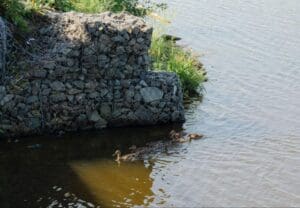The Environmental Benefits of Gabions
Gabions are often seen as a practical way of containing nature, from protecting from landslides to creating fencing and barriers. This traditional technology containing nature has a modern resurgence with clear environmental benefits. Gabions, cages filled with rocks, can help maintain the integrity of slopes and surfaces against natural impacts or changes in weather conditions.
This helps maintain a consistent, secure environment for both humans and wildlife. They also act as a form of natural filtration and water capture, helping to reduce runoff and improve water quality. Furthermore, they can provide habitat for wildlife such as reptiles and help maintain biodiversity. Gabions help to protect and support the environment in a variety of ways, such as:
1. Reduce CO2 Emissions
One of the major environmental benefits of gabions is their ability to reduce CO2 emissions. Gabions are great for reducing CO2 emissions due to their ability to store carbon and absorb pollutants from the air, such as methane and carbon dioxide. This process is known as carbon sequestration, as it helps to absorb and store carbon in the atmosphere, preventing it from entering the environment directly. When rocks are placed in the gabion, they can absorb and store these gasses, reducing emissions. Furthermore, the gabion itself also absorbs some of these gasses, further contributing to the emission reduction.
Gabions also aid in water filtration and capture processes, reducing carbon emissions by capturing and recycling rainwater. This can be especially useful in preventing silting caused by built-up water. Through this process, the gabions can filter and capture pollutants, preventing them from entering the environment and aiding in reducing the number of pollutants and, consequently, CO2 emissions.
If vegetation is allowed to grow within a gabion wall, it can further contribute to the carbon removal of the solution. Plant life in a gabion wall will actively take in CO2 during photosynthesis. This forms an incredibly beneficial cycle as the plants take in CO2, releasing oxygen into the atmosphere. Furthermore, the oxygen released can help clean the air and encourage plant growth, further absorbing CO2.
In addition, gabions can also reduce CO2 emissions by reducing fossil fuel consumption. Gabions are made of sustainable and durable materials, such as stone, which is abundant and can last for many years. As a result, they require less energy to manufacture and distribute, resulting in a reduced carbon and energy footprint for any given application. Therefore, using gabions not only helps to reduce emissions but also helps to create a more efficient system for reducing energy use and waste.

2. Uses Natural Resources
Gabions are made of natural resources, which helps to make them an eco-friendly choice for many applications. Gabions are made of rocks, which are plentiful and renewable; there is no need for costly construction materials, as rocks can be taken from areas nearby. As such, gabions are more cost-effective when compared to alternative methods of construction and more sustainable than timber or cement construction.
The abundance of gabion materials can help reduce energy consumption. Tractors and excavators require energy and fuel to operate, and the transportation of materials is also a heavy polluter. By doing all of these tasks with natural resources, less energy is needed to complete them, which helps reduce emissions and energy costs associated with manufacturing and transport.
Moreover, gabions use the natural environment to their advantage by relying on nature’s filtration process. The rocks within the cages act as a natural filter system, helping to capture pollutants, chemical contaminants, and debris. This helps keep nature clean, improving the wildlife habitat of the surrounding area and protecting water sources.
The cage is also made of natural resources, such as steel mesh, which is durable and long-lasting. This helps increase the system’s sustainability while protecting against the elements. In addition, steel is recyclable and can be reused, helping to minimize waste usage and any potential environmental damage.
3. Erosion Control
Gabions can reduce erosion, helping protect the land from nature's forces. This benefits many applications, such as working roads, homes, parks, valuable land, and coastal areas. Gabions act as a form of armor against rapid disintegration, helping to prevent soil loss and protecting any settlements that may be nearby. If loose soil, rocks or other materials are placed within the gabion, this can help hold it in place and reduce the chance of it sliding away or becoming entirely washed away.
Additionally, gabions protect against landslides and floods, which can cause considerable damage and disruption to communities. Providing a secure barrier, typically much stronger than other alternatives such as timber or metal fences, significantly reduces the risk of events like these. Furthermore, they can be placed along coastlines, reefs, and other vulnerable habitats, helping to protect these areas from damaging weather and wave conditions.
Erosion control is important for development projects. Gabions can provide an efficient and cost-effective solution for controlling disintegration around infrastructure, providing long-term protection against the elements. Gabions are also becoming popular for protecting slopes due to their strength and sturdiness. By providing a stable, secure environment, developers can safely begin their projects while helping to prevent any negative environmental impacts.

4. No concrete foundation is needed
Gabions do not require a concrete foundation, often needed for other protection methods. This is because they are filled with rocks, which are heavy enough to provide the required stability and tension when in place. This eliminates the need to prepare a concrete foundation, which often disrupts terrain and uses large amounts of energy in its preparation. There is also less risk of contaminating nearby areas with concrete when using gabions.
Furthermore, gabions can be disassembled and reused easily, unlike a concrete foundation that needs demolishing. This makes gabions a great alternative for temporary prevention methods. Gabions are often the best choice for mitigating a natural disaster or a temporary fix as they require less energy and resources. Reusing and moving them to another location is often much easier than preparing a concrete foundation or breaking it down, and is highly beneficial to the environment.
Gabions provide an aesthetically pleasing and natural look, often used in parks and open recreational spaces. In this regard, gabions add to the beauty of nature and can help bring out the hidden potential of certain areas. This is beneficial for humans and animals, as it can provide much-needed recreational spaces and habitats.
5. Noise Barriers
Gabions are also an effective tool for noise reduction. They are composed of densely packed stone and mesh, which helps to dissipate sound, creating a natural protective shield. Therefore, they are often used as noise barriers in urban areas and gardens to reduce noise from busy roads or nearby houses.
The mass and density of gabions can absorb sound waves, cutting down the sonic footprint of an area. This helps preserve any given space's peace and quiet, making them ideal for outdoor recreational areas, schools, gardens, and other places where noise levels can impact the quality of life or productivity.
Gabions can also help reduce wall vibration and associated noise in buildings like railways and motorways. They are designed to absorb vibrations, creating a more peaceful environment and reducing noise pollution effectively. Moreover, with their naturally aesthetically pleasing design, gabions are a great addition to any garden; they help block out unwanted sounds and create a soothing ambiance.
The mesh also helps to filter wind, helping to buffer wind pressure and create a protective environment. This can be especially useful when dealing with coastal areas, where storms can cause considerable damage. Gabions are often used in such areas, where their mass and protective qualities help prevent the serious risks of coastal weather.
6. Retaining Walls
Gabions are also a cost-effective and sustainable way to create retaining walls, helping support the earth embankments and preventing soil movement and potential structural failures. Gabions can help to hold the earth in place, reducing landslides and soil movement, which can have devastating effects in vulnerable areas.
When filled with soil, they act like a living retaining wall, providing a growing environment for plant life and nutritious ground to help species thrive. This is an incredible environmental benefit, as it can help boost biodiversity and preserve wildlife habitats. Furthermore, their hygroscopic properties can help with soil moisture balance, ensuring a healthy and consistent environment for any species.
When reinforced, gabion walls can also make excellent retention for any structure, providing protection and increased stability. They are often used in retaining sites, where they help to protect buildings from potential erosive strategies, such as waves and soil disintegration.
7. Cost effective
One of the most rewarding benefits of using gabion walls is their cost-effectiveness. Gabions are made with natural resources, such as stone, and can be easily sourced in various ways, reducing the cost of acquiring them. Additionally, gabions are reusable and can be easily moved from site to site as needed, reducing the cost of making changes.
They are easier to install and quicker to construct than most other building sites, reducing the effort and resources needed. Furthermore, they are incredibly durable and will last many years without maintenance. This helps to reduce long-term costs and increases savings for any given application.

Gabions are also easy to maintain, helping to reduce both the monetary and environmental costs of upkeep. Their steel mesh cladding helps to protect against the elements and maintain the structure for years without needing to be replaced. Furthermore, they can be quickly dismantled and moved elsewhere, making them an incredibly cost-effective solution for most applications.
8. Natural beauty
Gabions also add a natural and aesthetic beauty to any setting. This is an incredible benefit in many applications, as it helps to boost the outdoor environment and create a more enjoyable ambiance. Gabions can often be found in city parks or gardens, where they help to separate a grassy or wooded area from cluttered, busy streets.
The aesthetic element gabions bring to a space is very important for promoting environmental stewardship, as it helps to inspire people to appreciate and care for nature. Furthermore, they can be designed to fit any aesthetic and theme desired, such as a classical French style or a rustic countryside look.
Gabions look great around bodies of water, such as lakes and rivers, where they help to reduce wave disturbance and maintain the natural, serene atmosphere. This is an incredibly beneficial benefit for any recreational area, as their natural beauty attracts more visitors.
Gabions can also make wonderful additions to homes, gardens, and commercial centers. Whether for a front yard, backyard, or garden, gabions help create a natural, open space that helps illustrate nature's beauty. This can benefit the local environment as people learn to appreciate the nature around them, helping to promote environmental stewardship.
Conclusion
Overall, gabions are a centuries-old technology experiencing a modern resurgence due to its ample environmental benefits. They are made of natural resources, ingeniously designed to reduce lingering environmental impacts and provide a strong, resilient structure for many applications. Gabions bring many environmental benefits, from reducing CO2 emissions and energy consumption to providing cost effective solutions and aiding in destruction control.
Moreover, they help to add a touch of natural beauty to any space, helping to promote environmental stewardship and raise awareness of the importance of preserving nature. Gabions are a great way to bring an eco-friendly solution to any application, helping to protect the environment and maintain a sustainable, healthy environment for all.
